
Why Schools Should Have More Playground Equipment
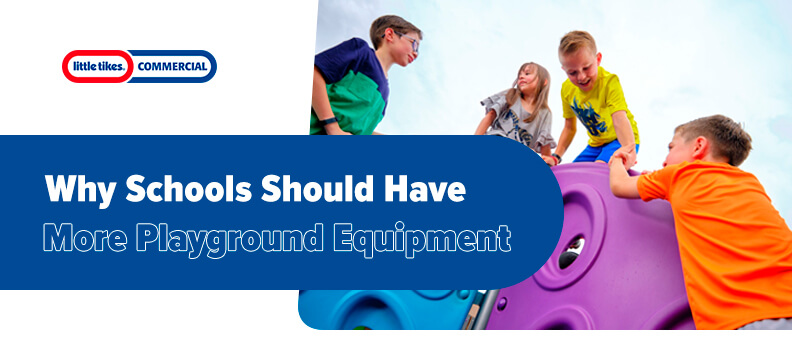
Schools should have more playground equipment because they provide safe and constructive spaces to encourage students to play and learn. Having a playground can increase student engagement and make students more energized throughout the school day. Playground time is an eagerly anticipated part of each day, so it’s crucial to give every student ample time to play and enjoy themselves.
Read on or jump ahead to a specific section:
- Benefits of Playgrounds for Schools
- Playground Equipment to Add
- Choosing Little Tikes
- Contact Us Today
Benefits of Playgrounds for Schools
Check out these physical, social, emotional, and mental incentives for students of adding a playground to your school.

Physical Benefits
Physical activity is essential in a healthy lifestyle, and it’s vital to reinforce positive habits in children. For students, recess is the time to step away from the classroom and let loose a little. They can release their pent-up energy and enjoy free play. Having an outside playground helps foster better physical health, as it encourages kids to get active and use their imaginations.
Here are five physical benefits of playgrounds for students.
- Strength: School playground structures have many features that challenge kids’ physical abilities. Playgrounds are ideal places to help kids develop muscles, from climbers that build upper extremity strength to swing elements that enhance core and leg strength. Being stronger can help kids prevent and avoid injuries, and will improve their performance in sports later on.
- Flexibility: Stretching and enhancing flexibility is another benefit of playgrounds for schools. Reaching for bars, stepping up large steps, and other actions can help stretch children’s muscles. Improving flexibility has a host of benefits for children, including reducing the likelihood of injuries from pulled muscles and helping with growth spurts. It can also help with agility, making more complex movements easier.
- Sleep: Getting enough physical activity can have enormous benefits for sleep. Sleep is essential to foster physical and cognitive skills, and it can even have benefits like boosting immune systems and improving the ability to fight off diseases. Physically exerting themselves on the playground benefits children’s sleep schedule, which in can help them in many other areas of their lives.
- Coordination: As kids grow from babies to toddlers to children, their coordination improves. Some of the first skills they develop are grasping and holding — as they grow up, they learn to balance and do other complex movements. Playground equipment for schools fosters children’s coordination by testing their physical abilities and providing safe places to exert themselves physically.
- Energy: When you can provide physical activity for children, it helps regulate their energy levels. Student energy builds up throughout the day, especially if they’re in a classroom most of the time. Having an outlet to let off steam keeps them from becoming too hyperactive. It might also help improve their alertness, especially as they transition from having daily naps in school.
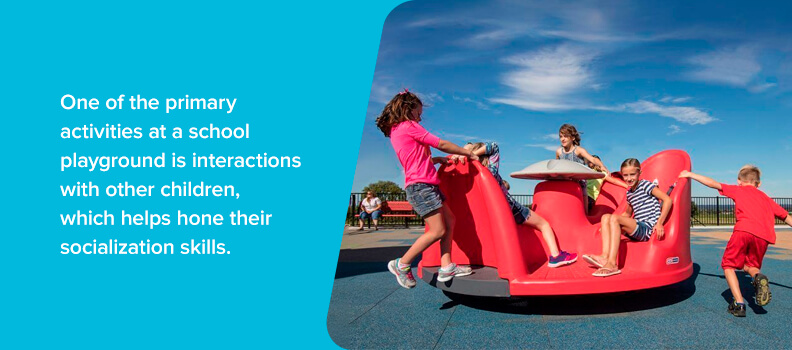
Social Benefits
Encouraging student play has social benefits, too. One of the primary activities at a school playground is interactions with other children, which helps hone their socialization skills. Making friends is essential to having a healthy life, so here are the social advantages of playtime.
- Cooperation: Some playground elements encourage collaboration through structures that require more than one user. Equipment like the Maypole needs multiple children to push the tilted wheel. Spinning equipment that takes multiple operators, like the Revolution Inclusive Spinner, encourages kids to work together to propel them around.
- Sharing: In addition to cooperation, playing on a playground can help kids learn the essential skill of sharing. In schools with limited resources, kids must share toys and playground equipment. Students will have to take turns on the slide and swing sets, so it’s vital to learn to work together.
- Friendships: There’s no better place to make friends than on a playground. With various themes and custom playground options, these spaces bring out kids’ imagination, which makes forming bonds even easier. When students can play together in a structured and safe environment, it’s an excellent way to foster lasting friendships and bonds.
- Independence: While many elements of playgrounds encourage group play and relationship building, they also help students practice independence. Conquering their fear of heights by going down the tallest slide on their own or successfully climbing the ladder without help for the first time can help make kids more independent.
- Behavior: While it may seem counterintuitive, the social benefits of unstructured play on a playground can improve behavior. Having recess and playing on an outside playground can help improve their memory and concentration on other tasks. It’s also shown to reduce instances of disruptive behavior.
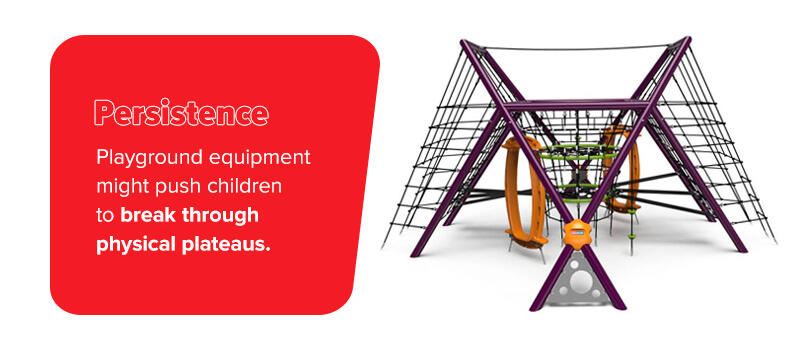
Emotional Benefits
Another benefit of school playgrounds is emotional. Playing can be therapeutic for children when it encourages positive emotions and feelings. Check out five of the top emotional benefits of playgrounds for schools.
- Patience: From playing with others and sharing, kids learn patience. The ability to stay patient helps kids gain self-control and reduces their frustration. Often, when children get impatient or upset, they will lash out at others. Playing with friends at school can teach them how to act when they encounter frustration or jealousy.
- Empathy: As a social space, playgrounds provide students with opportunities to forge relationships with others. When they can interact with children from different areas and backgrounds, they develop empathy. When they think about other children’s feelings, they become more respectful and compassionate and forge healthy relationships.
- Persistence: Sometimes, playground equipment might push children to break through physical plateaus. If they encounter a piece of challenging playground equipment, such as the Grand Strand climber, it can inspire them to work hard and persevere to get over their fears and climb to the top.
- Courage: While playground equipment manufacturers keep strict safety considerations in mind, students gain confidence and courage from trying challenging physical feats on the playground. Climbing, swinging, and heights may be intimidating for some children, but with proper supervision and encouragement, the playground can teach them they can overcome anything they set their mind to.
- Resourcefulness: Even though challenges may initially frustrate children, figuring out how to solve problems or overcome obstacles will build their resourcefulness. When they can solve problems on their own, it will improve their self-esteem and make them more resilient.
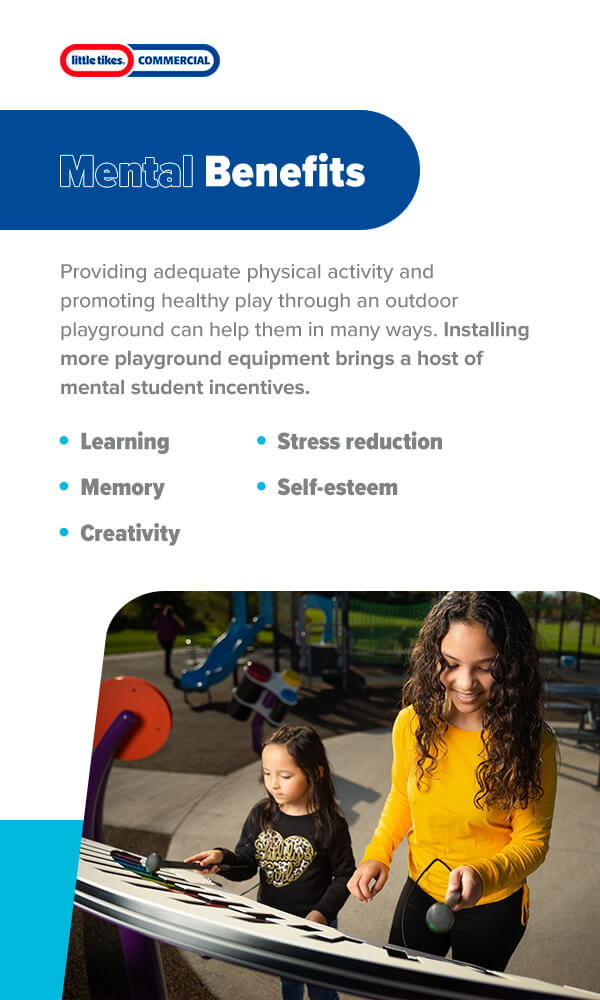
Mental Benefits
In recent years, people have begun to place a heightened focus on mental health. While children are still learning about their emotions and developing skills such as patience, empathy, and communication, it’s critical to recognize and support students’ well-being. Providing adequate physical activity and promoting healthy play through an outdoor playground can help them in many ways.
Installing more playground equipment brings a host of mental student incentives.
- Learning: Play is essential to learning. When children play, their brains make new connections between nerve cells, which allows them to retain the information they learn in school. Additionally, while many people see recess as a break from learning, playing outside on a playground has a host of learning opportunities, from social skills to learning how the world works.
- Memory: Similarly, the cognitive development students get from play enhances their ability to remember information. At school, students spend hours learning complex topics. However, the brain needs time to sort through, analyze, and store this valuable information. Playing on an outdoor playground provides a “brain break” so students can catch up and continue learning fresh when they return to the classroom.
- Creativity: With various themes and exciting features, playground equipment can inspire students’ imagination. Children have a natural curiosity and creativity — playgrounds can foster their imagination and inspire them to create pretend worlds where anything can happen.
- Stress reduction: While elementary school may not seem that stressful to older children and adults, students in these grades can experience pressure. Playing is a wonderful outlet to reduce stress, as it can release endorphins in the brain that alleviate anxiety. Having playgrounds at school is essential to provide children with a healthy outlet to release their stress during the school day.
- Self-esteem: Play can also boost children’s self-esteem, as they gain practice and confidence communicating and working with others. Overcoming challenging obstacles on the playground equipment and successfully collaborating with their peers makes them more confident, preparing them to progress through life with a better outlook.
Playground Equipment to Add
If you’re preparing to start a new playground or you have outdated equipment that needs updating, consider popular, inclusive, and age-appropriate playground equipment to add to your outside playground. Installing a new playground or updating specific elements keeps your outdoor play area fresh and enhances students’ enjoyment during playtime.
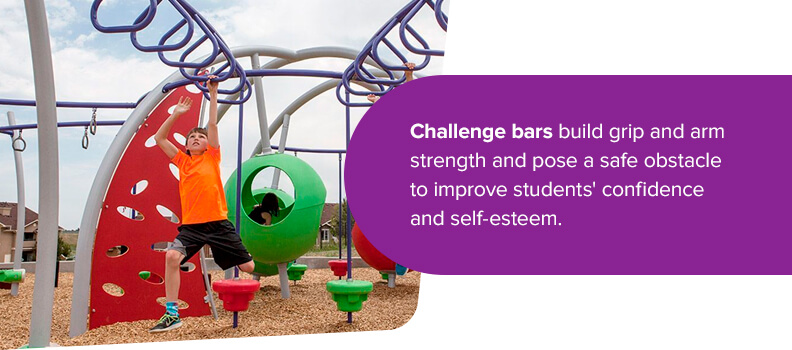
Popular Playground Equipment
Some pieces of playground equipment are classics. When kids see a playground, these are the elements they almost always look for because they provide maximum enjoyment and fun. Here’s some of the most popular playground equipment to consider adding.
- Slides: Slides are so fun, and many children want to ride them again and again. You can choose a freestanding slide or a composite slide that connects to other playground equipment. There are also many different types of slides, including some that allow multiple students to slide down together and ones with tunnels and spirals.
- Swings: What kid doesn’t love the feeling of flying through the air on a swing? Swings may take a bit to get the hang of, and they might challenge children’s fear of heights. Still, swinging can help calm down students and reduce their stress levels. Swings are a fantastic addition to any playground because they build core muscles and provide hours of fun.
- Tunnels: Tunnels provide outstanding opportunities for exercise. They challenge students’ motor skills to crawl or scoot through the tunnel and are ideal for pretend play and interactive activities. They also offer a secure and enclosed environment for students to retreat to if they feel overwhelmed or need a break.
- Activity panels: Another popular playground element is activity panels. These playground features promote educational stimulation and problem-solving skills for students, making them an excellent addition to school playgrounds.
- Challenge bars: There are hundreds of variations for challenge bars, an exciting twist on the classic monkey bars. Challenge bars build grip and arm strength and pose a safe obstacle to improve students’ confidence and self-esteem.
- Spinners: Nothing beats a merry-go-round, but that’s not always the most convenient for a school playground. Luckily, there is smaller, more compact playground equipment that children can operate themselves — spinners. These elements provide tons of fun and encourage cooperation and group play.
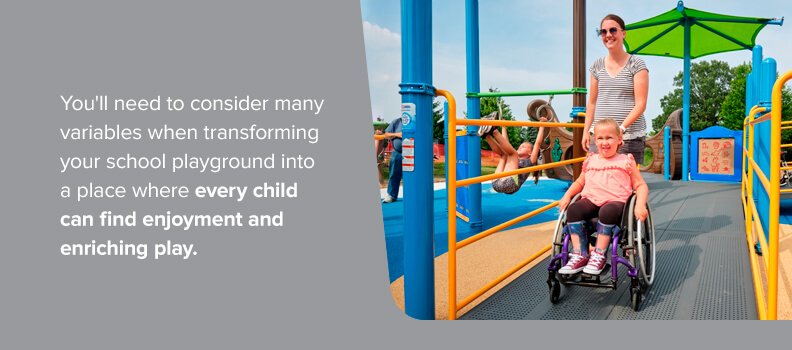
Inclusive Playgrounds
Other essential features to add to your school playground are inclusive elements that allow children with special needs to enjoy the playground alongside their able-bodied peers. You’ll need to consider many variables when transforming your school playground into a place where every child can find enjoyment and enriching play.
- Space: Spacing is a critical consideration, as children or parents with wheelchairs need enough room to move around on the playground. Furthermore, spacing on the equipment itself is also essential so every ability have options to enjoy it.
- Sound: Sounds are inevitable on a playground — children get excited, which often comes with shouts, squeals, and cheers. However, some children need quiet spaces, as sound can easily lead to overstimulation.
- Surfaces: Consider what surface your playground has and whether it allows children to move around freely. Steps, loose ground cover, and hard surfaces can pose risks, which is why soft, cushioned surfacing free from obstacles is the best safety option.
- Graduated Complexity: Another element to consider is the graduated complexity of play. While some children can climb to the tallest part of the playground structure, not all children will be able or willing to go that high. Therefore, it’s essential to have engaging elements on every level of the playground.
In addition to making your playground with a universally inclusive design, you should also include elements specifically for children with wheelchairs and other special needs. The Americans with Disabilities Act maintains that playgrounds must have ADA-compliant elements, like ramps and ground-level components, to help children and adults with disabilities navigate the space. However, an inclusive playground exceeds these standards, providing a space that fully engages children of all abilities.
Swings are a favorite playground element, and you can provide opportunities for every child to enjoy the sensation of flying through the air. The Inclusive Seat for swings has a three-point harness to help children stay in the seat while swinging, in addition to a headrest for extra head and neck support. Unlike classic swings, this seat has four durable chain connections for maximum stability and safety.
Another fantastic piece of inclusive playground equipment is the Together Glider. Featuring plenty of room for children with disabilities or with wheelchairs, 10 or more children can fit on the structure at a time. With a compatible ramp, this glider can be fully wheelchair-accessible. It also has benches for those who want to sit and rails for people who want to stand.
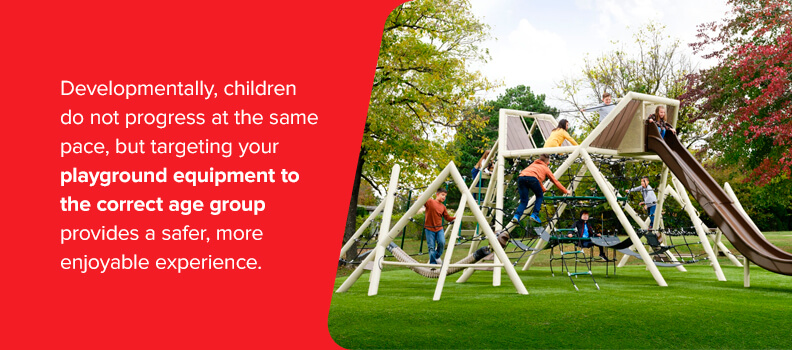
Age-Appropriate Playground Equipment
In addition to ensuring the playground equipment is engaging and inclusive, having safe equipment for every age group is another vital consideration. Developmentally, children do not progress at the same pace, but targeting your playground equipment to the correct age group provides a safer, more enjoyable experience. Keep the following groupings in mind.
- Children ages 2-5: These children, likely in preschool or day care, have smaller body proportions than school-aged kids, so they need equipment scaled down to their size. Smaller steps, low platforms, ramps, and handrails are excellent for children in this group, as they explore their expanding mobility.
- Children ages 5-12: Children in this age group enjoy a wider range of physical abilities, which opens up more possibilities for playground equipment. Climbing structures and challenge bars are two examples of playground elements that are more appropriate for children in this age group than younger ones.
- Children ages 2-12: With such a large age range, your inclusive playground must offer features that fit younger kids who are still getting used to their mobility and others who have more developed physical abilities. Additionally, having a range of activities on different levels offers everyone access to engaging playground fun.
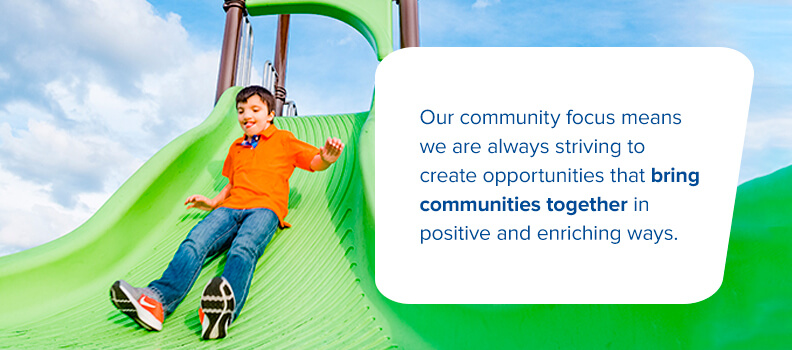
Choosing Little Tikes
Fostering student playtime and imaginative play is an essential responsibility, and Little Tikes Commercial has the experience and dedication to craft quality playground equipment. With options for custom and themed playgrounds, you can choose from complete playgrounds to individual components to add to an already established playground.
We believe in inclusive design so every child can enjoy the benefits of playgrounds for students, no matter their ability or background. Our community focus means we are always striving to create opportunities that bring communities together in positive and enriching ways. Kids learn skills on playgrounds that will benefit them for the rest of their lives. The advantages of playgrounds help children grow up to be responsible citizens and community members.
Safety Features for Playgrounds
One aspect that distinguishes Little Tikes Commercial is our commitment to safety. We consider safety first and foremost in every project we approach, and we work beyond the necessary safety and compliance standards for playgrounds. From the big-picture design to the tiniest manufacturing details, we take pride in considering every aspect of safety for engaging fun.
Additionally, we take an active role as a playground safety industry leader. We continue our commitment to safety even after design and installation with information on who to contact for safety audits, inspections, and maintenance.
Request a Quote Today
Should schools have more playground equipment? We know the answer is a resounding yes! Ensuring students have a space to improve their mental, emotional, physical, and social states means they can lead happier and more balanced lives. If you’re looking for more information on how to create a safe and engaging playground for your school, contact the experts at Little Tikes Commercial.
If you’re ready to begin your journey to build a playground that will benefit your students and community, find your representative today!

